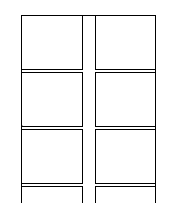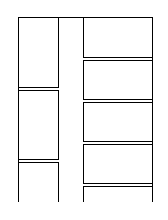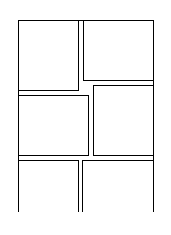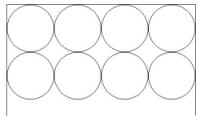| Notes on stowage and securing of various goods [46] |
[German version] |
Cartons, boxes and crates
When loading cartons in a container, two points in particular should be borne in mind:
| The load-carrying capacity of the cartons reduces as humidity levels rise. | |
| If cartons are able to move in the container, they may easily suffer abrasive damage. This can be prevented by tight stowage, filling of dead space and bracing of the cargo. |
The following procedure is recommended for packing:
| If the cargo does not require the entire volume of the container, arrange the cargo such that it covers the entire floor area to a uniform height. This ensures uniform weight distribution. In addition, less material is needed for cargo securing and working time is saved through lower lifting heights. |
|
| Start packing at the front of the container (opposite the door), beginning from the sides and moving inwards. |
|
| Utilize the space as efficiently as possible so that no dead space is left. |
|
| Particularly tight stowage may be achieved, if the packages are overlapped like bricks. |
|
| The packages may be secured to each other and to the floor with lumber connectors, thereby preventing the cargo from moving. |
|
| If unused space remains, brace the cargo row by row during stowage. |
|
| Accommodate large, heavy crates in the middle of the container and brace them against the corner posts. When bracing against the side walls, ensure that loads are well distributed. |
 Figure 1 |
 Figure 2 |
Back to beginning
Pallets, forkliftable unitized loads
Pallet dimensions decisively determine capacity utilization of the container: The most favorable pallet size is a function of the internal container dimensions and the shape and weight of the packages.
Four-way pallets (accessible by fork-lift trucks from all four sides) allow the floor area available in the container to be put to the best use.
The following Table shows the stowage patterns recommended for the standard pallet sizes:
| Pallet size [mm] [inch] |
20′ Container | 40′ Container | ||||
|---|---|---|---|---|---|---|
| Stowage pattern | Max. no. | Utilization of floor area [%] | Stowage pattern | Max. no. | Utilization of floor area [%] | |
| 1000 x 800 40″ x 32″ |
1 | 14 | 83.2 | 1 | 28 | 81.2 |
| 1100 x 800 44″ x 32″ |
1 | 14 | 91.4 | 1 | 28 | 89.3 |
| 1100 x 900 44″ x 35 1/2″ |
1 | 12 | 88.1 | 1 | 26 | 93.3 |
| 1100 x 1100 44″ x 44″ |
1 | 10 | 99.7 | 1 | 20 | 87.7 |
| 1100 x 1400 44″ x 55″ |
1 | 8 | 91.3 | 1 | 16 | 89.3 |
| 1200 x 800 48″ x 32″ |
2 or 3 | 11 | 78.4 | 2 or 3 | 23 | 80.1 |
| 1200 x 1000 48″ x 40″ |
3 | 10 | 89 | 2 or 3 | 20 | 87.0 |
Stowage pattern 1 for pallets: |
Stowage pattern 2 for pallets: |
Stowage pattern 3 only for four-way pallets: |
 |
 |
 |
Where pallets are transported in containers, it is important for the cargo to be firmly secured on the pallets and for the pallets to be firmly secured in the container:
| Attach the cargo securely to the pallet with straps, adhesive or shrink-film. | |
| 2 to 4 lumber connectors underneath each pallet are enough to secure the pallets (in single-layer stowage). | |
| If only one row of pallets fits into the container, position the row centrally. | |
| If there is space for two or more pallets across the width of the container, position the rows tightly against the container sides. | |
| Always leave any unavoidable dead space in the middle of the container, in order to achieve uniform weight distribution and to simplify lashing as far as possible. |
 Figure 3 |
Back to beginning
Barrels, metal drums and polydrums
1. The following procedure is recommended for loading barrels and metal drums:
| Prior to loading, ensure that the barrels or drums are not leaking; do not load leaking barrels or drums. | |
| Always arrange barrels or drums so that their tap openings are at the top. | |
| Metal drums are best loaded upright and close together. The optimal arrangement of the barrels or drums on the container floor may be determined by dividing the width of the container by the diameter of the individual barrels or drums. |
| Barrel diameter | Stowage pattern | Number per layer in 20′ container |
Number per layer in 40′ container |
|
|---|---|---|---|---|
| inch | cm | |||
| 10 | 25.4 | Full | 207 | 432 |
| 11 | 27.9 | B | 168 | 344 |
| 12 | 30.5 | B | 154 | 315 |
| 13 | 33.0 | A | 119 | 252 |
| 14 | 35.5 | B | 102 | 216 |
| 15 | 38.1 | Full | 90 | 186 |
| 16 | 40.6 | B | 80 | 165 |
| 17 | 43.2 | B | 65 | 140 |
| 18 | 45.7 | Full | 60 | 130 |
| 19 | 48.2 | A | 59 | 120 |
| 20 | 50.8 | B | 52 | 108 |
| 21 | 53.3 | B | 44 | 88 |
| 22 | 55.8 | Full | 40 | 84 |
| 22.5 | 57.1 | Full | 40 | 83 |
| 23 | 58.4 | A | 39 | 80 |
| 23.5 | 59.7 | A | 36 | 79 |
| 24 | 61.0 | A | 36 | 76 |
| 24.5 | 62.2 | B | 30 | 66 |
| 25 | 63.5 | B | 30 | 63 |
| 26 | 66.0 | B | 27 | 57 |
| 27 | 68.6 | B | 24 | 53 |
| 28 | 71.1 | B | 24 | 51 |
| 29 | 73.7 | Full | 23 | 48 |
| 30 | 76.2 | Full | 21 | 45 |
| 31 | 78.7 | A | 21 | 45 |
| 32 | 81.3 | A | 20 | 42 |
| 33 | 83.8 | A | 20 | 41 |
| 34 | 86.4 | B | 14 | 30 |
| 35 | 88.9 | B | 14 | 28 |
| 36 | 91.4 | B | 14 | 28 |
| 37 | 94.0 | B | 12 | 26 |
| 38 | 96.5 | B | 12 | 24 |
| 39 | 99.1 | B | 12 | 24 |
| 40 | 101.6 | B | 11 | 23 |
| Stowage pattern „Full“: |  |
| Stowage pattern A: |  |
| Stowage pattern B: |  |
The number of rows (from front to door) may be calculated using the following formulae:
| For stowage pattern „Full“ and „A“: Internal container length / drum diameter | |
| For stowage pattern „B“: 1 + [(Internal container length – drum diameter) / (0.866 * drum diameter)] |
In the door area, the barrels and metal drums must be secured. There are several ways of doing this:
| Bracing with wood | |
| Encircling with steel strapping, preferably interlinked in the manner of Olympic rings | |
| Staggered stowage (achieved by differing barrel or drum heights or using empty pallets) keeps the top layer firm |
The curved nature of wooden barrels makes them unsuited to absorbing stress. Therefore, when they are stowed on their sides, the following measures should be taken: Support the barrels at the ends, such that the curved area does not come into contact with the container floor, and use to wedges to secure them against rolling.
2. When loading polydrums in containers, two points in particular should be borne in mind:
| Check polydrums for leaks, since a leaking polydrum endangers the stability of the entire stow. | |
| Cover all layers with stowage gratings or dunnage, to ensure stow stability. Otherwise, jolts from below or vibration may easily cause „bulging“ of a layer (bulging effect) and result in individual drums popping out. |
Back to beginning
Bagged cargo
The following losses may arise from improper stowage of bagged cargo in containers:
| The bags slip out of the container when the container doors are opened. | |
| The container walls bulge out due to excessive pressure. This may cause the container to become jammed in its slot in the ship, which may result in damage during unloading. |
To prevent losses, the bags should be stowed in such a way that they cannot move during transport. There are two possible ways of doing this:
| Criss-cross stowage: this does not prevent slippage in the case of plastic bags, however. | |
| Palletization of bags: the bagged cargo is secured on the pallet by plastic strapping or by shrink-wrapping with plastic film. The most favorable pallet size is a function of the internal container dimensions, the bag shape and the weight of the payload. |
Back to beginning
Bales
Many bales are relatively insensitive to mechanical stresses arising during transit, but are particularly susceptible to damage during loading and unloading. The following procedure is therefore recommended:
Take care during loading that the outer covering of the bales is not damaged.
To allow subsequent unloading with fork-lift trucks, lay wooden planks on the floor and between each bale layer in the longitudinal direction of the container during loading.
If the bales do not extend so as to be flush with the door, bracing against the corner posts is generally sufficient for cargo securing and for making safe on the door side.
Back to beginning
Rolls and coils
Rolls and coils may be loaded in containers upright (i.e. with vertical axes, „eyes to sky“) or on their sides (i.e. with horizontal axes). Different rules apply for stowage depending on whether the rolls are paper rolls or steel coils.
Horizontal loading:
Paper rolls can be stowed in several layers. Secure the bottom layer of rolls with wedges. Lay plastic mats between layers to increase friction. Fill spaces at the sides.
Store heavy rolls of steel sheet on a wooden bed with a high loading capacity and support them on beams or sleds to increase the bearing surface. Secure the rolls to the sled with steel straps or disposable belts through their central holes. Reinforce the end walls of the container additionally by transverse beams at the level of the roll middle. Fill spaces with wood.
Vertical loading:
Stow paper rolls close together, fill dead space. Secure with nets or beams on door side.
Stow rolls of steel sheet likewise close together. For cargo securing purposes, attach to one another with steel straps or brace with wood. Ensure that heavy rolls of steel sheet loaded on skids or pallets are attached securely to them.
Back to beginning
Machinery, heavy-lifts and out-of-gauge cargoes
These cargoes may also be transported in containers, door-to-door transport being particularly advantageous, since the cargo has then to be secured only once.
Particularly careful cargo securing is necessary when transporting heavy-lifts or out-of-gauge cargoes. It is imperative that the following points be observed:
The regulations relating to admissible land transport sizes and weights in both the shipping and receiving countries must be taken into account.
Make sure at point of loading that the receiver of the cargo has the machinery and other equipment needed to unload the cargo from the container.
All measures necessary for transport must be taken in good time beforehand.
Machinery and heavy-lifts
Machinery and heavy-lifts are often loaded into the container from above. Open-top containers with tarpaulins, hard-top containers or flatracks are available for this purpose.
Due to the relatively high loading capacity of the container floor, only flatracks or platforms are usually suitable for heavy-lifts. Flatracks may be used for door-to-door transport.
The following procedure is recommended for cargo securing:
If only one item is loaded into the container, position it in such a way that the center of gravity of the cargo is as close as possible to, and better still below, the geometric center of gravity of the container.
Individual heavy items require load-distributing beds, since the point loading of such items is often too great for the container floor. The maximum values for the floor load-carrying capacities of standard and open-top containers are 4.5 metric tons/m (20′ containers) and 3.0 metric tons/m (40′ containers). If only two beams are used, they must lie lengthwise and be spaced from one another by at least 80 cm.
Where packages are arranged on a wooden sled, bolt the latter securely to the cargo. Brace the sled against the corner posts and the bottom side rails and bottom cross members of the end and side walls, as far as possible not only at floor level but also at the level of the cargo’s center of gravity (horizontally against the corner posts). Where the cargo is top heavy, bracing at the level of the center of gravity is particularly important. When bracing against the side walls, ensure that loads are well distributed.
Out-of-gauge cargoes
Open-top containers, flatracks or platforms are suitable for out-of-gauge cargoes, depending on the direction in which the package exceeds the internal dimensions of the container.
In general, the same rules apply with regard to cargo securing of out-of-gauge cargoes as for heavy-lifts. If the cargo is covered with special tarpaulins, stow the unused original tarpaulins and the roof bows securely in the container.
Back to beginning
Vehicles
All types of vehicle, from automobiles to road-building machinery, can be transported by container ship.
If the vehicles contain gasoline, diesel, fire extinguishers, airbags or starter batteries, compliance with hazardous materials regulations must ensured.
| Automobiles and vans Vehicles of this type may easily be driven into standard containers (if necessary with the assistance of a small ramp). The vehicles must be completely dry when loaded. To allow air exchange, open the windows slightly. Special rapid tensioners are available for lashing automobiles and vans. |
|
| Trucks, road building machinery and harvesters Vehicles of this type may be loaded in open-top containers with tarpaulins or hard-tops, on flatracks or on platforms. Cargo securing may be achieved using wire rope with turnbuckles. Position additional wedges in front of and behind the wheels (wedge height at least one sixth of wheel diameter). |
Back to beginning
Glass sheets
Glass is best loaded into the container from above owing to its dimensions or weight. Open-top containers with tarpaulins or hard-tops are available for this purpose. In addition to careful packaging of glass sheets in boxes, crates or on A-frames, further cargo securing measures may be adopted:
| Stow glass sheets as far as possible lengthwise in the container. | |
| If several A-frames are located one behind the other in the container, any spaces must be filled or braced. | |
| Provide glass with an additional covering, since it is very sensitive to moisture. |
Back to beginning
Liquids
Liquids may be transported in tank containers. The following should be noted:
Tank containers must be at least 80% full, to prevent dangerous surging movements in transit.
Tank containers should not generally be more than 95% full, to allow for possible thermal expansion of the contents.
Liquid bulk bags may also be used in standard, open-top or bulk containers to transport nonhazardous liquids, such as wine or latex.
Back to beginning
Solid bulk cargoes
Unpackaged solid bulk cargoes may be transported in 20′ bulk containers, and also in standard or open-top containers with an inlet.
Bulk, standard and open-top containers are provided with lashing rings for suspension of the inlet.
Cargo securing on the door side is necessary, and indeed stipulated by law for export to some countries.
Back to beginning
Long goods
Under certain conditions, long goods are best loaded into the container from the side or from above owing to their dimensions or weight. Open-top containers with tarpaulins, hard-top containers or flatracks are available for this purpose.
The following procedure, for example, is recommended for cargo securing: clamp the entire container cargo together with steel strapping previously introduced into the container. The intermediate layers must be filled in with wood, to prevent long goods from sinking into the cantline of the layer beneath and thereby increasing the pressure on the side walls of the container. In the case of transport on flatracks, insert stanchions and tie them together above the cargo, to prevent spreading.
Lay material between the individual layers of long goods which increases slip resistance, since long goods readily slide in the longitudinal direction and thereby exert stress on the end walls. Build in a vertical wooden bulkhead between the cargo and the end walls, to divert the pressure of the cargo to the corner posts and prevent point loading.
Back to beginning
